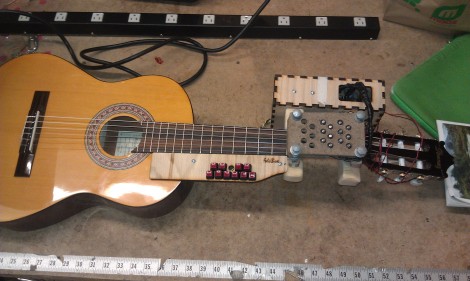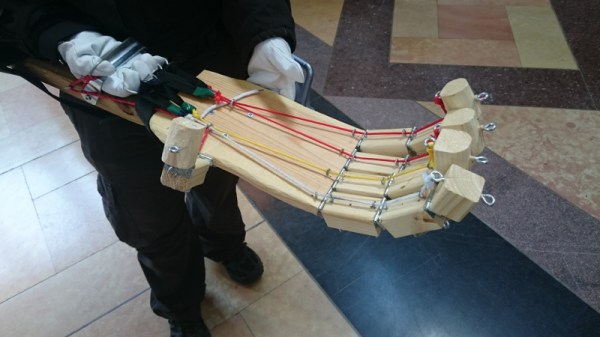Are robotaxis poised to be the Next Big Thing™ in North America? It seems so, at least according to Goldman Sachs, which issued a report this week stating that robotaxis have officially entered the commercialization phase of the hype cycle. That assessment appears to be based on an analysis of the total ride-sharing market, which encompasses services that are currently almost 100% reliant on meat-based drivers, such as Lyft and Uber, and is valued at $58 billion. Autonomous ride-hailing services like Waymo, which has a fleet of 1,500 robotaxis operating in several cities across the US, are included in that market but account for less than 1% of the total right now. But, Goldman projects that the market will burgeon to over $336 billion in the next five years, driven in large part by “hyperscaling” of autonomous vehicles.
dexterity8 Articles
Hackaday Links: April 27, 2025
Looks like the Simpsons had it right again, now that an Australian radio station has been caught using an AI-generated DJ for their midday slot. Station CADA, a Sydney-based broadcaster that’s part of the Australian Radio Network, revealed that “Workdays with Thy” isn’t actually hosted by a person; rather, “Thy” is a generative AI text-to-speech system that has been on the air since November. An actual employee of the ARN finance department was used for Thy’s voice model and her headshot, which adds a bit to the creepy factor.
A Hacker’s Guide To Getting Old
It’s no surprise that things change as we age, and that tasks that were once trivial become difficult. Case in point: my son asked for help with the cord on his gaming headset the other night. The cable had broken and we could see frayed conductors exposed. When I got it apart, I found that I could barely see the ultra-fine wires to resolder them after cutting out the bad section. I managed to do it, but just barely.
This experience got me thinking about how to deal with the inevitable. How do you stay active as a hacker once your body starts to fight you more than it helps you? I’m interested mostly in dealing with changes in vision, but also in loss of dexterity and fine motor skills, and dealing with cognitive changes. This isn’t a comprehensive list of the ravages of time, but they’re probably the big ones that impact any hacker-related hobby. I enlisted a couple of my more seasoned Hackaday colleagues, [Bil] and [Rud], for their tips and tricks to deal with these issues.
Maker Faire Kansas City: Coming To Grips With The Mechanics Of Dexterity
There is always a great variety of things to see and experience at the Kansas City Maker Faire. This is the fifth year for the event which is held at historic Union Station, a beautiful art deco train depot from a bygone era. With a multitude of booths and exhibits across two floors and a vast outdoor area, there is something for pretty much everyone. Often times, the interesting things are mobile conversation-starting creations. When we saw [Dan] walking around with a giant wooden contraption on his arm, we knew we must find out more about it.
The impetus for [Dan]’s project was his desire to pick up a soda can using a mechanical grip. He now believes this to have been a lofty goal, given the weight of a full can of the stuff. This prosthetic hand is made from wooden finger segments that are connected by small, continuous hinges. Each of [Dan]’s gloved fingers curls around a metal ring to control that digit’s large wooden analog. On the inside of the hand, sections of paracord run underneath strategically placed eye bolts on each finger segment and are tied off at the fingertips. A second set of eye bolts on the back of the hand anchor the network of rubber bands that provide resistance. Although he made it look easy to open and close the hand, [Dan] said that it’s pretty heavy to lug around and somewhat strenuous to use. Next time, he’ll probably go with foam or 3D-printed pieces.
Dexterity Enhancing Guitar

[Justin Lange’s] dad loves playing guitar, but an accident left him with nerve damage that makes it pretty much impossible these days. He just doesn’t have the dexterity needed to form the cords using his left hand. But his son’s hacking skills are helping him get back into it. [Justin] built a button-based add-on that forms the cords for him.
The build has two parts. A frame mounts over the finger board with slots for eighteen solenoids which push the strings down between the frets. These are controlled by the replacement finger board which is mounted below the neck. It has a double-row of buttons that let the player select the desired chord. One button chooses the key, with a second button acting as a modifier to switch to a seventh cord, or minor cord.
The project, which [Justin] has named folkBox, relies on a microcontroller. We spy an Arduino Mega in one of the build photographs but it will be interesting to see if the final project moves to a standalone chip. He’s set a goal for a more robust version of the build some time this summer.
[via Make]
Awesome Robots Love Fanta
[youtube=http://www.youtube.com/watch?v=SOESSCXGhFo]
What you are seeing above is not a commercial for Fanta, though we think it would have been a good one. It also isn’t being played at an accelerated speed. That is a real time demonstration of the accuracy and speed the ABB robots achieve. We were surprised, even shocked, when we clicked play. We don’t know who came up with this idea, but we want those robots, and we want some Fanta. We’re a bit curious what industry needs beverage tracing robots though.
The last time we saw such amazing feats of robot awesomeness, they were bouncing balls and catching stuff in mid air.
Home Built Delta Robot
[youtube=http://www.youtube.com/watch?v=7bQRXfLwBgU]
Theres an interesting thread going on at RoboterNetz.de (translated) about building delta robots. For those who haven’t seen delta robots before, be sure to check the video after the break for some really impressive agility displays. A delta robot usually has 3 arms connected to a single point at the end. This configuration allows the end point to maintain its “level” while the whole unit is moved, usually very quickly. There are a few people building them in this forum. The one pictured above is [Asurofilmchen]’s version, but you should also check out [Radbruch]’s posts of a robot made by [Jamison].














